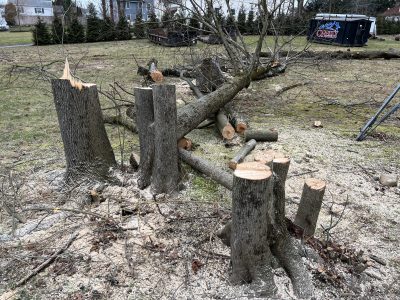P’ville’s Proposed Tree Ordinance Receives Pushback From Residents
News Based on facts, either observed and verified directly by the reporter, or reported and verified from knowledgeable sources.

Planting more trees in the village to compensate for the quickly-disappearing canopy prompted the Pleasantville Conservation Advisory Council (CAC) to propose a new tree ordinance last January.
Another main goal of the ordinance is to strengthen penalties for violating site plans and for removing trees without permits.
CAC members Ben Serebin and Michael Inglis addressed the draft ordinance at last Tuesday’s Village Board work session, hoping that it prompts greater public awareness and response.
Inglis said there has been tree canopy loss throughout Westchester, not just in Pleasantville. In the last 20 years, he estimated the village has lost 15 to 20 percent of its canopy.
Inglis displayed a large map of the village showing the areas where trees have been lost over the years and where more could be planted.
The CAC found 140 locations in the village that had lost canopy due to aging trees or disease.
“There’s a lot of space in Pleasantville to plant trees,” Serebin said.
If enacted, the proposed ordinance would institute fines for violations such as cutting down a tree without a permit, damaging a root zone, clear-cutting and planting invasive species.
Last March a developer building two houses on Clark Street eliminated trees without approval. The violation raised the ire of the community; the developer apologized but wasn’t fined because there is no mechanism to impose monetary penalties.
Homeowners looking to remove trees on their property would be limited to eliminating five trees a year. If property owners decided against planting new replacement trees, they would have to make a donation to a new village tree fund that the ordinance would authorize to establish to pay for planting trees elsewhere in the village.
The proposed ordinance suggests that tree removal permit applications be reviewed, and approved or denied by the building inspector, the Planning Commission or the Village Board.
Trees that would likely be given the greatest consideration for removal are ones that threaten nearby existing structures and invasive species such as Norway maple. Property owners intending to replant replacement trees would be preferred.
When asked about the potential fine schedule or tree fund contributions, Serebin said that has not been decided.
Last January’s submission of the draft ordinance suggested that contributions could depend on the size of the tree that would be removed. A tree with at least a four-inch Diameter Breast Height (DBH) but less than 12 inches would require a contribution of $200 per tree; a tree measuring at least 12 inches but less than an 18-inch DBH would cost $300; a tree with an 18- to 24-inch DBH would cost $400; and a tree greater than 24 inches would cost $500.
“We looked at other tree ordinances and some have fees that are too low,” Serebin explained.
Pleasantville resident Tom Rooney disagreed with the idea of charging residents who wanted to remove trees on their property.
“I think it’s ridiculous that I cannot put my hand in your pocket but you can put your hand in my pocket,” he told the Village Board and CAC members. “I can’t see how I have to pay a fee to cut down a tree for any reason on my property. For me, to contribute to a fund which is not a contribution, it’s another tax on us, the residents of this village. It’s absurd. Hard enough to live in this town with the increase in taxes.”
Rooney, however, applauded the idea of planting more trees around the village.
“I love trees. But for me and anyone else in this village to cut down a tree on my property is my business, not yours,” he said.
Resident Michael Peppard said caring for the 47 trees on his property is his biggest expense.
“Several large trees are crowding each other out,” Peppard explained. “The tall trees along the road prevent us from growing vegetables and make solar panels impossible. I just had several thousand dollars for safety pruning done last week and that happens every year.”
Peppard said he planned to top seven cedar trees bordering his property along Church Street and remove another three trees that were trapped under a sugar maple and were dying.
“The estimated cost to do that is between 4 and $7,000,” Peppard said. “Under the proposed ordinance, would I have to pay fines for taking these 10 trees down in addition to the thousands of dollars to do the work?”
Resident Ellen Norton said that when she moved to Pleasantville in 2017, she planted 34 trees on her property.
“I’m a tree lover but I don’t want to have to come get a permit to take care of something on my own property,” she said. “I feel that it’s none of the local government’s business.”
Norton said she would urge the village to reconsider the proposed ordinance by targeting commercial developers and those buying and building on large properties.
“Developers who remove trees without approval should be fined and you should shame them,” Norton said. “Don’t punish me and good, well-meaning citizens for somebody else’s crime.”
By the end of the hourlong discussion, village Trustee Paul Alvarez commended Serebin and Inglis for their years of work in crafting the ordinance.
“You’ve put in a lot of effort by looking at all the studies that have been done and using examples from other villages,” Alvarez said. “We still have a lot to look at, and obviously it’s concerning to know how much canopy we’ve already lost. Maybe it is possible to tackle the issue from the village side first.”
Alvarez said he understood the concerns residents raised at the meeting.
“We are not trying to infringe on your liberty when it comes to your own property,” he said. “There is that start that needs to happen and we are in that start.”
Westchester municipalities that passed new tree ordinances, mainly in the 1980s, included Irvington, Scarsdale, Tarrytown, White Plains and Mount Pleasant. Lewisboro has the oldest tree protection ordinance in the county, which went into effect in 1977.

Abby is a local journalist who has reported on breaking news for more than 20 years. She currently covers community issues in The Examiner as a full-time reporter and has written for the paper since its inception in 2007. Read more from Abby’s editor-author bio here. Read Abbys’s archived work here: https://www.theexaminernews.com/author/ab-lub2019/
